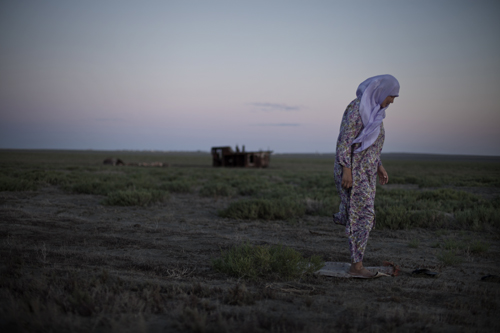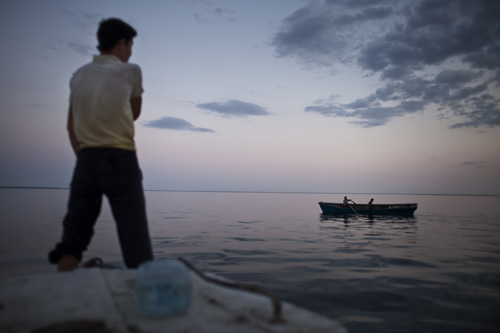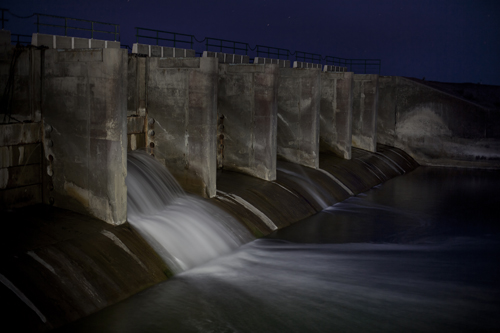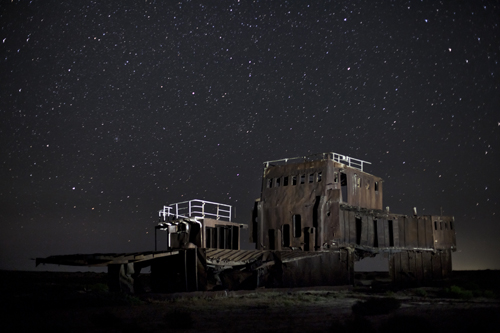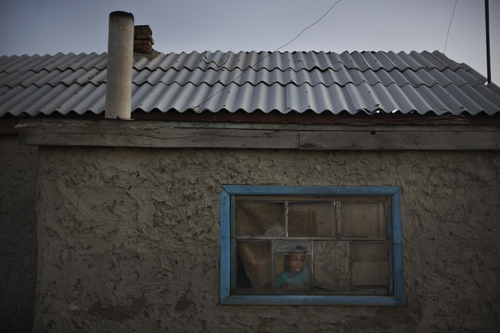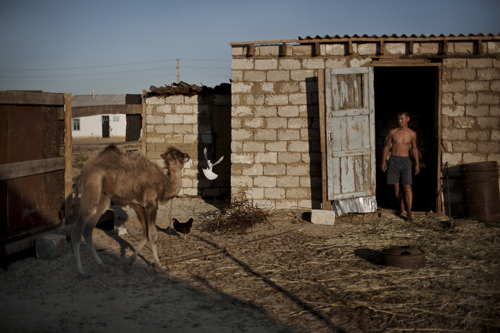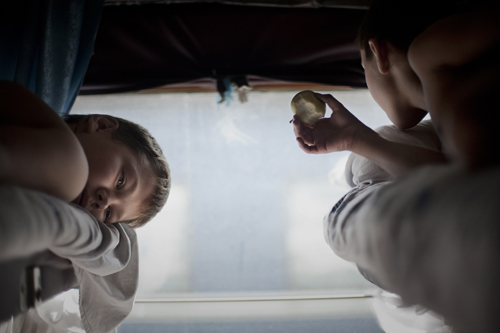
- Brothers look out the train window at what used to be the Aral Sea, now a stretch of desert dotted with camels grazing on the way to Aralsk.
She stood amid the boat carcasses, in a wide stretch of wasteland, at what was once the bottom of the sea in her brightly colored hijab. She covered herself only when praying, a seemingly liberal practice for someone so devout, but during Soviet Rule most Kazakhs had been forbidden to pray. Mira’s reasons, however, were more complex; she hoped to one day adorn herself in hijab when she felt worthy of it. Life had become mired in endless doctors visits and trips to Russia for expensive eye operations for her five-year-old daughter, Inabat. Since birth, Inabat has suffered from a rare congenital malfunction known as Marfan Syndrome, an illness that causes excessive growth of the limbs, as well as heart irregularities and sight problems. Many in the surrounding villages and towns of the Aral Sea suffer from chronic health problems after one of the worst environmental disasters of the twentieth century caused the world’s fourth largest lake to shrink to one quarter of its original size. Mira attributed her misfortunes to this collective tragedy. She couldn’t even remember the last time she had been to see the sea, believing now that it was only a myth, something to hope for but not to expect. But she told us the sea had been calling her.
In the 1960s, the Syr Darya and the Amu Darya rivers were diverted by the Soviets to irrigate cotton plantations. Deprived of its two main tributaries, the shores of the Aral Sea, which spanned from the North in Kazakhstan to Uzbekistan at its Southern tip, began to recede— taking with it the fishing industry, as well as much of the sustainable agriculture of both countries. The damming also left behind miles of desert where fresh water had once flourished, with sandstorms now becoming frequent during the increasingly hot, dry summers. And what remained of the waters of the Aral was turned into an hyper-salinated pool of agricultural pesticides, killing off most remaining fish and surrounding wildlife as well. Health problems and unemployment pushed droves of people into neighboring cities and towns. Such was the case with Tactubek. A once thriving fishing town of more than a hundred houses near the water’s edge, it now rests twelve kilometers away, with just twenty houses occupied primarily by fisherman and their families. Camels, roaming the dirt roads, outnumber inhabitants.
In 2001, though, after years of failed attempts by locals to construct a manmade dam, the World Bank together with the Kazakh government responded with the thirteen kilometer Dike Kokaral, an $86 million project, designed to raise the water level of the Northern Aral Sea by containing flow into the severely diminished Southern part of the Sea. Extirpated species of fish were reintroduced, and a Danish NGO donated fishing nets to local villagers. “This project has taken eighteen years to realize,” Sagi Aidarali recounted as he untangled the flounder flapping in his nets. His father had been a fisherman on the Aral Sea, but, like many a fisherman of his time, he was sent by the Soviets to fish on the Irgiz, another great lake in Kazakhstan. He was not so sentimental as many Kazakh men who grew up under Soviet Rule, but as he recalled in a low voice the days when his father would take him to the Aral Sea by motorbike to fish, in a wooden boat similar to his own, using the same kind of nets that he held now in his hands, I saw his lips curl slightly into a smile.
From here the sea seems far from returned. Though brides still ride around in wedding cars in this traditional marriage town, there is something about Aralsk that has died. It is a beach town with no sea, a surreal endless expanse of sand.
The fishermen of Tactubek are a testament to the human desire to correct the wrongs of the past. Mira’s cousin, Texiran, who began fishing while in high school, first touched the sea when he was thirteen. His family was from Tactubek but moved to the neighboring village of Saksaylsk when the sea “closed down”—as locals say. Texiran’s mother sold goods on the intercity trains to bring in income while his father was unemployed, but Texiran led his family back to Tactubek when he began fishing. Up before the sun, men like Texiran surface from their handmade bungalows carved from the sand. Jury-rigged with electricity and sunroofs, these homes are nothing more than humps dotting the beach with antenna-like chimneys. The fishermen mix their chai with Russian Vodka and head out in hopes of heavy catches—and substantial earnings from the fishmongers sent from Aralsk.
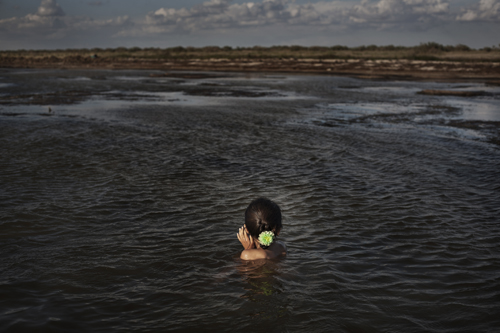
- Seven-year-old Madina, from the nearby Village 85, bathes in the Aral Sea near Tactubek. This was her third trip to the sea.
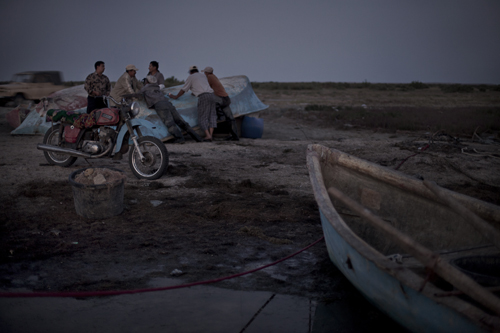
- Nineteen-year-old Nyrbek (left) lights a cigarette in front of his handmade sand bugalow with his fellow fishermen, after a hard day’s work.

- Nyrbek cooks dinner for himself and his brother Islam. Their grandfather was a fisherman on the Aral Sea, but the two grew up in Saksaylsk without ever seeing the sea.
Aralsk, once a strategic port town, at the Northern tip of the Aral Sea, thrived on the trading of commodities between Russia and Central Asia at large. Although the dam has brought the shoreline to within 25 kilometers from what was once the Aralsk Harbor, one would never know it. “We heard about the sea coming back,” Bakitgul Korenova, a pensioner had told me, lounging in her daybed outside her home in the Doshniazov neighborhood, “and we hope that it’s true.” Doshniazov is a conglomerate of governmentsubsidized housing, built in the early 1980s on top of what used to be the sea. Bakitgul’s sons, save for one who is mentally disabled, have all moved away to find opportunity in larger cities in Kazakhstan. Most of the young men of Aralsk have found work in the oil companies in Kyzlorda, if they are lucky enough to find work at all. They would rather be fishermen, but fishermen must have their own boats and nets, as well as a car to reach the sea.
Catch levels are also still very low, with yearly production projected at 10,000 metric tons for 2012. The main fishing plant, a sleek new structure, sits behind a large wrought iron gate, seemingly out of service for the moment. Just across the sandy road, camels graze around a pool of water crested with brown foam and ringed with garbage. From here the sea seems far from returned. Though brides still ride around in wedding cars in this traditional marriage town, there is something about Aralsk that has died. It is a beach town with no sea, a surreal endless expanse of sand. Women push their baby carriages through mounds of white grain sand; abandoned boats dot the harbor, half-submerged in shallow ponds. One can’t help but wonder how Aralsk will respond when and if the sea actually does return. More than a generation has grown up here in the arid desert; they have never known life on the water.
I wonder about Mira. When I first met her she was so resigned to the loss of the Aral—something I would later realize was due to the pain its absence had caused her. She had long hoped the sea would come back; she lived on this dream. Maybe in some ways it would vindicate her life sacrifices. I watched her as we approached the shore and the thin sliver of turquoise grew bigger along the horizon. I wrapped my arms around her stomach as we jostled through the sand dunes on the motorbike. Although she was nurturing and motherly, I saw Mira, in this moment, as a free spirit, unshackled from the burden that had become her life. Her feet sank into the wet sand and a serene smile crept upon her face. She reclined into a fisherman’s boat and let herself, if only in her dreams, drift out onto the new depths of the Aral Sea.




